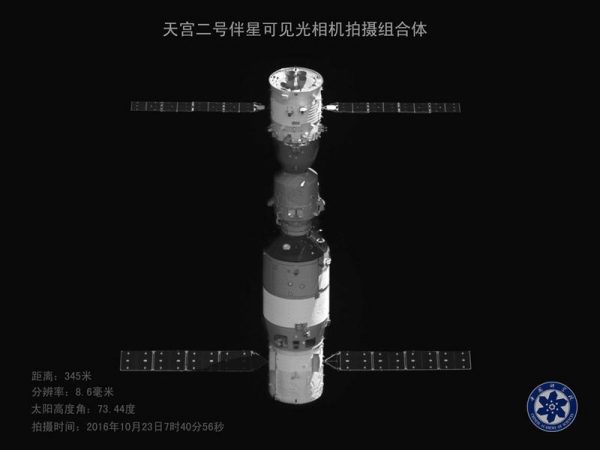China set to deorbit disused Tiangong 2 space lab – Spaceflight Now

China’s Tiangong 2 space lab, a precursor to the country’s planned space station, is scheduled to fall out of orbit Friday and plunge back into Earth’s atmosphere for a destructive re-entry.
Chinese officials announced the end of Tiangong 2’s mission Saturday. The spacecraft will fire its thrusters to slow its speed and fall out of orbit Friday, targeting a re-entry zone over the South Pacific Ocean between New Zealand and Chile, according to the China Manned Space Engineering Office.
The human-rated space lab hosted two Chinese astronauts on the Shenzhou 11 mission in 2016 for a 29-day stay. The Shenzhou 11 crew, led by commander Jing Haipeng with crewmate Chen Dong, spent more than 32 days in space on the their flight in late 2016, the longest mission to date in China’s human spaceflight program.
The China Manned Space Engineering Office, which oversees the country’s human spaceflight program, said the Tiangong 2 module has completed its experiments orbit. Most of the spacecraft will burn up during the fiery re-entry Friday, but some components could survive and splash down in the remote South Pacific.
A previous test craft for China’s planned space station fell back to Earth last year in an uncontrolled manner.
The bus-sized Tiangong 2 space lab launched Sept. 15, 2016, on top of a Long March 2F rocket from the Jiuquan space base in northwestern China.
The Shenzhou 11 spacecraft and its two-man crew docked with Tiangong 2 a month later for their four-week stay. After Shenzhou 11’s departure, China launched a robotic refueling freighter in April 17 to dock with Tiangong 2 and carry out a series of tests to demonstrate capabilities for servicing China’s future space station.
The Tianzhou 1 refueling spacecraft docked with Tiangong 2 three times, testing maneuvers needed for fast-track rendezvous profiles that will allow future cargo and resupply freighters to dock with China’s planned space station as little as six hours after launch.
While attached to Tiangong 2, the Tianzhou 1 spacecraft pumped rocket fuel and oxidizer into the Tiangong 2 space lab, the first such in-space refueling activity in China’s human spaceflight program.
The Tiangong 2 spacecraft measures about 34.1 feet (10.4 meters) long, and its main body has a diameter of about 11 feet (3.35 meters). The space lab’s two solar array wings extend to a span of about 60 feet (18.4 meters) tip-to-tip.
The China Manned Space Engineering Office said the Tiangong 2 spacecraft is in good condition after more than 1,000 days in orbit, and added that re-entry preparations are progressing well. The space lab was designed for a two-year lifetime.
Chinese authorities said in a statement they will release further information after Friday’s re-entry to fulfill China’s international obligations.
The grounding of China’s heavy-lift Long March 5 rocket has raised doubts over the schedule for the launch of the first element of multi-module Chinese space station. China is building the space station’s core module for launch on a Long March 5 booster, but the rocket has not launched since suffering a failure in July 2017.
Several missions are ahead of the Chinese space station in the Long March 5 manifest, once the rocket resumes operations. They include the launch of a large Chinese communications satellite, the Chang’e 5 lunar sample return mission, and a test flight of the Long March 5B variant, which is configured for missions to haul space station modules into orbit.
A Chinese Mars lander is also supposed to take off on a Long March rocket in July 2020.
China says the human-tended orbiting complex should be completed by around 2022.
Email the author.
Follow Stephen Clark on Twitter: @StephenClark1.






